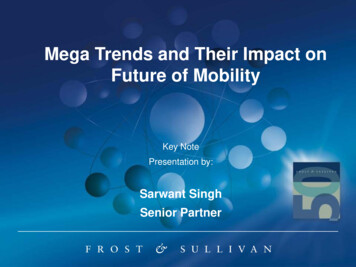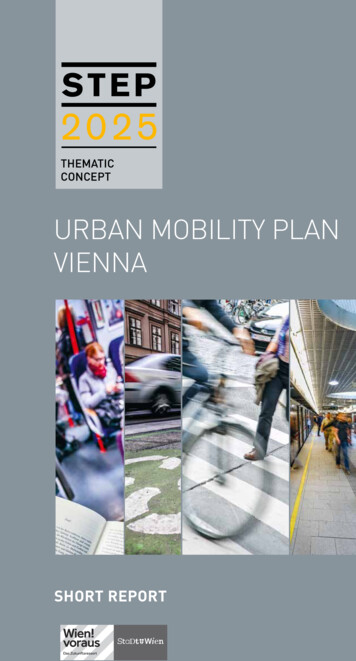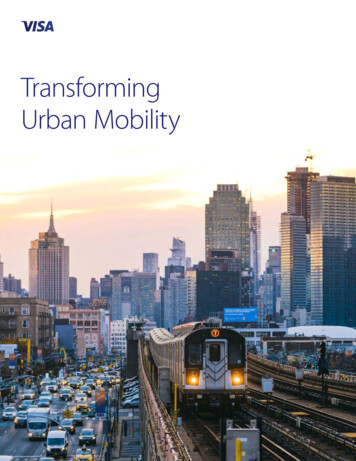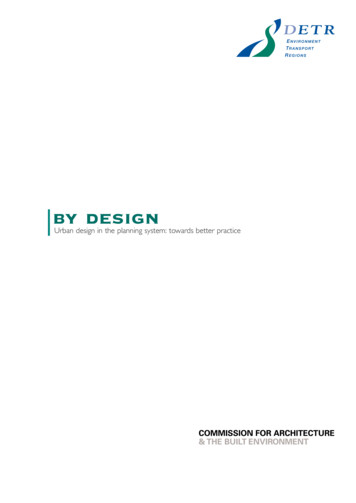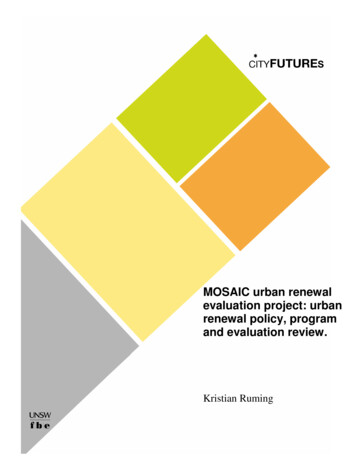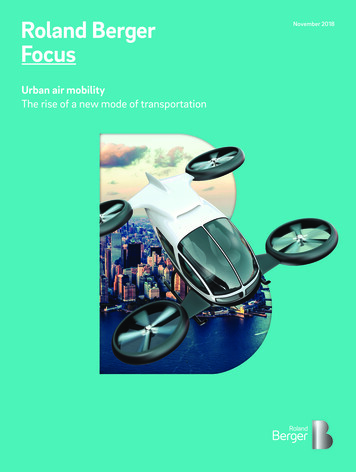
Transcription
November 2018Urban air mobilityThe rise of a new mode of transportation
2 Roland Berger Focus – Urban air mobilityManagement summaryDriven by increasing urbanization, the worsening baneof road congestion and new advances in aircraft technology and electric propulsion, the time is now ripe forthe emergence of urban air mobility (UAM) – the transportation of persons or goods via flying vehicles overurban areas – as a new industry. Close to 100,000 passenger drones could be in service worldwide by 2050.Over time, advances in electric propulsion, autonomousflight technology and 5G communication networks willspawn on-demand air taxi services, scheduled airportshuttles and intercity flights. Urban air mobility adds athird dimension to the urban transportation matrix. Itprovides an attractive solution for areas where merelyincreasing two-dimensional capacity would in no wayease the existing traffic situation. It also creates new opportunities for travelers for whom personal comfort andspeed are at a premium, as well as for rescue servicesand para-public applications. Urban air mobility willgradually be integrated in the existing mobility landscape, bringing a time-efficient mode of travel and asafe, enjoyable flight experience to more and more passengers at increasingly low cost. With flagship pilotprojects scheduled to go live in cities such as Dubai, Singapore, Los Angeles and Dallas in the early 2020s,better batteries, new aircraft designs and – as of the late2020s – autonomous flight technology will bring pricesdown and spread services to major metropolitan areasaround the globe.The winners in this exciting new market will be thosewho address its complex, interdisciplinary needs inclose collaboration with manufacturers, infrastructureand service providers and the relevant regulatory andurban authorities.The pivotal success factor is choosing the right use casefrom the broad array of aircraft/drone concepts. Eachhas its own benefits and limitations, and not all technologies suit all applications. Yet around this centralissue, further success factors will include developmentof a suitable infrastructure for take-off and landingspots, maintenance, energy supply and communication,the emergence of service providers with robust commercial and operating models, and a regulatory framework to control and govern safety, liability, emissionsand a host of other issues.
Urban air mobility – Roland Berger Focus 3Contents1. From dream to reality . 4Urban air mobility is poised to become a fast-growing business2. What form will UAM take in the future? . 9Three use cases3. The pivotal success factor . 13 Choosing the "right" aircraft4. It's not just about drones! . 15 Other key success factors for the UAM market5. Conclusion . 17Cover photo: GCShutter/iStockphoto; Chesky W/Getty Images How to implement UAM successfully
4 Roland Berger Focus – Urban air mobility1. From dream to realityUrban air mobility is poised to become a fast-growing businessUrban air mobility (UAM) is an attractive business proposition. Not too far off in the future, what is currentlythe exclusive preserve of the ultra-rich – flying over allthe traffic jams from one urban location to another –could become common practice. The potential benefitsof inner- and intra-city electrical vertical take-off andlanding (eVTOL) commutes are genuinely appealingand can be a perfect fit with the needs of customers ifthis nascent industry can deliver on five key promises:KEY PROMISE 1FASTEST TRAVEL OPTIONSaving significant amounts of time compared to taxisand subway lines, for example, would make the use ofurban air services highly attractive to passengers. Bearing in mind the time taken for boarding/de-boarding and actually getting to and from a landing hub,eVTOL aircraft need trips to be at least 15 to 25 kilo meters in order to deliver genuine time savings and become the fastest urban mobility option. If they doachieve this goal, they can bypass (and potentially ease)the hassle of congestion, while also streamlining thepoor connections to airports from which many majorcities still suffer today.KEY PROMISE 2REASONABLE FARESIn megacities such as São Paulo and New York, ultrahigh-net-worth individuals and top executives alreadycommute by helicopter from the airport to the city center, or between points in the city center. By contrast,the switch to electric propulsion and eventually autonomous flight operations will slash purchase prices andrunning costs for eVTOL vehicles by an order of magnitude, opening up the urban air experience to a muchwider target group. Unmanned flights based on autonomous technology will reduce costs still further. Poolingpassengers (e.g. from the airport to the city center)could then combine with the above cost reductions tomake the urban flight experience available at costs stillhigher than taxis but much more affordable than today'shelicopter services.KEY PROMISE 3SAFE AND ENJOYABLE FLIGHT EXPERIENCEAnyone who has ever flown over a city in a helicopterwill have experienced the jaw-dropping excitementand joy such a flight can deliver. The human desire tofly is an appeal that should not be underestimated,even though safety is naturally more important andmust be guaranteed at all times. Crucially, passengersmust also perceive this mode of transport as safe andreliable, and a robust regulatory framework will go along way to allaying passengers' fears. In the early stages, for example, flight attendants made available by theflight operator firms could likewise help many peopleovercome their understandable psychological reservations about autonomous aircraft in particular. The factthat electric propulsion will play a part in reducing carbon emissions in cities is another issue that will add toboth the real and perceived attraction of this mode oftransportation. However, it is not just the technical aspects that will make flights safe and enjoyable for passengers. Particular attention will need to be paid toenvironmental aspects, such as harsh weather conditions that would make the flight uncomfortable oreven unsafe.KEY PROMISE 4INTEGRATED MOBILITY SOLUTIONAttractive eVTOL solutions will dovetail with other localmobility services, giving passengers seamless connections from their location to the departure hub and fromthe arrival hub to their final destination. That alone willmark a major step forward from the complex, disjointedmobility chains we know today. Online booking apps
Urban air mobility – Roland Berger Focus 5A: Passenger drone operations forecastNumber of passenger drones in UAM operation worldwide ['000]9875532802020123202520302035Intercity flights2040Air taxis20452050Airport shuttlesNote: Estimated that 100 cities will have UAM operations in 2050Source: Roland Bergerwill arrange reservations and handle payment for whole journeys (e.g. calling a ride-hailing service to pick upand bring the passenger to the eVTOL hub, as well asbuying a subway ticket for the last-mile journey at theother end). In this way, a vastly superior door-to-doorcustomer experience will be guaranteed.Intelligent marketing that educates customers willnevertheless need to spell out these benefits. That willbe vital if urban air mobility is indeed to become a fullyintegrated and widely accepted mode of transportation.Initially, eVTOL will be positioned as a high-end prod-uct, gradually morphing into an integrated public transportation offering over time.KEY PROMISE 5PASSENGER-WINNING SERVICEAt the end, the winners will be the ones who create trulypassenger-winning services. Convenience will be a keymetric for customer adoption of eVTOL services. For example, take-off and landing locations will have to bestrategically positioned at areas of interest and easilyaccessible for travelers. This includes the already men-
6 Roland Berger Focus – Urban air mobilitytioned connection to other mobility services as well asquick access to landing pads, e.g. with dedicated elevators to rooftop pads. Waiting times also will have to bekept to a minimum, which would be optimized throughintelligent booking and dynamic passenger demandforecast algorithms.Aerospace companies and startups alike have joined therace to translate the vision of flying taxis from sciencefiction into reality before 2025. Many of the conceptsunder development even plan to do so without a pilot onboard. This study examines promising technical concepts and paints a picture of the emerging eVTOLecosystem with its stakeholders and key success factors.We also highlight where we see major challenges andhow they can be overcome. AMARKET POTENTIALOur research (see "Methodology" on next page), corroborated by numerous interviews with experts in the industry, indicates that close to 100,000 passengerdrones could be in the air worldwide by 2050. Something like 100 cities worldwide will have implementeddrone services to provide a variety of passenger transport services by then, with on average 1,000 passengerdrones in operation in each city. However, there will bea large spread of drones per city ranging in 2050 from 60drones for the smallest metropolitan areas to more than6,000 in the largest ones. Based on this scenario, droneswill become an integral part of urban (and supra-urban) mobility offerings over the next three decades. In thefirst few years, we foresee passenger drones mainly beingused as airport shuttles. While this service remains animportant use case going forward, the majority of passenger drones will later assume the role of point- topoint air taxis. Drones for longer-distance intercityflights will complement the passenger drone market.These three use cases are described in detail in chapter 2.We will see thefirst commerciallyused urban airmobility routesstarting in 2025.First pilot tests areexpected to startas early as around2020.
Urban air mobility – Roland Berger Focus 7MethodologyHow did we calculate market potential?The market potential is estimated based on bottom-up calculation of the number of urban aircraft required to offer viableeVTOL services in major cities.Four case study cities – Los Angeles, Munich, São Pauloand Singapore – were chosen as the point of departure forthis study. They reflect four distinct categories or "urban archetypes" in terms of population density and surface area:Singapore has by far the highest population density in nearlythe smallest urban area, while Los Angeles has the lowestpopulation density and the largest surface area.For each of these cities, potential urban air mobility routeslinking key traffic nodes (such as airports) to points of interest(city centers, shopping malls etc.) were identified based onB: Greater Munich metropolitan areaExample of estimated passenger demand basedon available commuter dataINGOLSTADTLANDSHUTMUCAIRPORTAUGSBURGthe urban architecture. One important factor was either theavailability of helipads or space to build new infrastructuresites. This issue was assessed with the aid of Google Earth, tosee where new ground infrastructure could potentially bebuilt, in conjunction with data available in the public domainregarding existing helipads.We then postulated the number of passengers for urbanair mobility services based on available commuter data aswell as percentages for switching to this new service basedon our interviews with numerous industry experts. The number of drones per route was then determined by the maximum number of passengers per hour at peak times.BPotential UAM routesMunich - Augsburg80 km 2,000 per day 9,100 per dayMunich - Ingolstadt80 km 1,800 per day 2,300 per dayMunich - Landshut73 km 450 per day 3,900 per dayMunich - Rosenheim67 km 1,100 per day 8,400 per dayAugsburg - Ingolstadt78 km 170 per day 170 per dayPotential UAM airport shuttleMUNICHDistanceCommuter demand[# of commuters][outbound / inbound]DistancePotential demandper route per day[# of travelers]MUC - Munich40 km 34,000Existing heliportMUC - Augsburg85 km 6,600Potential UAM routeMUC - Ingolstadt71 km 3,300MUC - Landshut41 km 1,600MUC - Rosenheim100 km, 75 km direct 1,400Potential UAM airport shuttleSize equals # of commutersROSENHEIMSource: Statistik Arbeitsagentur, Munich airport, Google maps, press research, Roland Berger
8 Roland Berger Focus – Urban air mobilityThe above assumptions and findings were extra polated for atotal of 98 metropolitan regions worldwide, each with at leasttwo million inhabitants and high GDP per capita. Dependingon their population density and surface area, these cities wereassigned to one of the four urban archetypes reflected by thefour named cities. This approach resulted, for Munich for example, in about 100 drones being in service for the three usecases in 2030 and up to 800 drones in 2050. The switchingrate increases over time and reaches on average 5% in 2050but varies per use case as well as per analyzed potential route.WHY IS NOW THE RIGHT TIME?gy and power densities improve, however, flights speedsand distances will increase accordingly.The dream of urban aviation is not a new one. Yet asurban sprawl increases and road traffic congestionworsens, several distinct technological advances areputting the long-held dream of escaping from all thismadness and taking to the air within our reach:Electric propulsion will make eVTOL cheaper than current models.1 Once the production of electric aircraftreaches maturity, the upfront cost of buying or leasingan eVTOL will be lower because electric powertrains aresimpler than gas turbines. Battery costs too are droppingthanks to the scale afforded by automotive manufacturing, and running an urban air taxi on electricity is morecost-efficient than running a conventional helicopter onkerosene. Electric powertrains also have lower maintenance costs due to their simplicity, although technicalservices have to be able to deal with high voltage. Thetotal cost of ownership of eVTOL is therefore expectedto be lower overall. By exactly how much will depend toa large extent on eVTOL architectures and configurations, as well as on local fuel and electricity costs. In thefinal analysis, the business case for eVTOL needs to bemade in comparison to both traditional helicopters andtaxis. Today, the available battery technology only allows short flight times for eVTOL applications. As ener-Autonomous flight technology is the second factor thatwill lower operating costs by rendering pilots obsolete.The extra free seat in each craft will also boost potentialby facilitating a significant increase in the payload.5G communication networks are a further technologicalenabler for the realization of air taxis. Whereas GPSbased satellite reception can be poorer because of highrise buildings, 5G will allow the ultra-precise navigationthat is needed for urban air mobility.Although these factors make now the time to pressahead with urban air mobility, this disruptive development will not be implemented overnight. The speed atwhich the above technologies progress limits the pace atwhich the UAM market can evolve. Moreover, workingservices and an attractive customer experience have yetto be created.See Roland Berger's Think:Act publication on "Aircraft Electrical ts/Global-Topics/Electric-Propulsion/)1
Urban air mobility – Roland Berger Focus 92. What form will UAM take in the future?Three use casesThe technological developments that are now makingurban air mobility a realistic possibility and the benefitsthis fledgling new mobility offering promises to deliver(see above) lead us to distill three main use cases forpassenger drone services – air taxis, airport shuttles andintercity flights – each with its own distinctive technological and operational requirements:AIR TAXISLike conventional ride-hailing services, this use casewill provide on-demand flights between any availablelanding pads within a defined area. To carry one or twopassengers and their light hand luggage (up to 20 kg intotal) over distances of between 15 and 50 kilometers,the aircraft technology would have to be able to copewith journeys of between 35 and 70 kilometers to ensurea safety margin of roughly 20 kilometers on all flights.Landing pads would be spread around the city to servicekey points of interest, with charging facilities ideally inplace at each station. Service providers would allow airtaxi rides to be booked on demand. Predictive trafficmanagement systems would enable aircraft to be dispatched based on passenger demand patterns and forecast demand at different landing pads. CC: Use case 1: Air taxisOn demand point-to-point operations On-demand point-to-point non-stop service from one destination to another Optimally used under the following circumstances:- Short distance between two landing sites- Fluctuating medium/high demand between two landing sites High network coverage Fastest travel times between two points Schedule frequency depending on # of air taxis High number of routes to cover all points Large amount of landing sites required to create network Sufficient air space (no restrictions) required to make useof direct point-to-point networkUAM landing siteSource: Roland BergerMetropolitan areaOn demand service02550km
10 Roland Berger Focus – Urban air mobilityAIRPORT SHUTTLESCovering similar as well as longer distances comparedto air taxi services, airport shuttles would offer scheduled (rather than on-demand) flights between variouslanding pads and the airport. The aircraft technologywould need roughly the same range as for air taxis, butwould be upsized to carry between two and four passengers and between 50 and 80 kg of luggage. Landingpads would be located at strategic locations around thecity and, obviously, at the airport. Charging facilitieswould be concentrated primarily at the airport, butwith some at the other landing pads as a function ofdistance and aircraft travel range. Passengers couldbook seats for fixed routes on a scheduled flight, completely eliminating the need for demand forecasts andmaking aircraft location and demand at each stationentirely predictable. DINTERCITY FLIGHTSIntercity flights would likewise be based on scheduledservices between specified cities that are too close to beviable for regular aviation links. The technology wouldhave to be able to carry two to four passengers and 20 to40 kg of hand luggage over distances of between 50 and250 kilometers, plus a safety margin of an extra 50 kilometers. Charging facilities would be installed at eachD: Use case 2: Airport shuttlesScheduled short-range operations Scheduled operations with fixed flight plans and pre-booked flights Flight schedule adjusted to arrival and departure times of airport UAM landing sites strategically located very close to terminal and gates Fastest transportation option between airport and city Transfer from plane to UAM on air-side of airport possible(very short transfer times) Interference with commercial airline operations problematic Scheduled operationskm0UAM landing siteSource: Roland BergerMetropolitan areaOn-demand serviceScheduled service2550
Urban air mobility – Roland Berger Focus 11landing pad, which would ideally facilitate direct accessto key points of interest in the cities served. As with airport shuttle and regular aviation services, flights atset times and on fixed routes could be booked in advance. Again, operational scheduling requirementswould be entirely predictable. EWHEN WILL ALL THIS HAPPENThough the race to get to market begins now, thesethree services will not all be implemented at once. Threekey developments over the next decade will be instrumental in shaping the evolution of the UAM market: Improvements in battery technology and new forms ofelectric propulsion will increase flight ranges from 20 to30 kilometers today to more than 100 to 250 kilometersby 2030. At the same time, advances in automation technology will usher in fully autonomous flights that cancarry more passengers and/or luggage. Prices for theend user will gradually come down, with 50-kilometerdrone flights costing double or triple the comparabletaxi price in 2020, but becoming much more affordablein the years to come. As this happens, the market forurban air mobility services will grow very rapidly. Between five and seven hubs and roughly 30 to 40 vehicles per city will initially be required to launch this kindof transportation service (based on the interviews weE: Use case 3: Intercity flightsScheduled medium- to long-range operations Intercity flights to other larger cities close by, which are too close even for regional airlines Fast UAM connection between cities favorable for commuters and business travelers Short travel times let metropolitan areas grow closer Significantly reduced travel times between two cities The only high-speed travel option without muchinfrastructure need (compared to establishinghigh-speed train services) Scheduled operations with predictable demand Long flight times pose challenges to technology(batteries, motors etc.) Alternate landing sites required along the wayin case of emergencyUAM landing siteSource: Roland BergerMetropolitan areaOn-demand servicekm0Scheduled service100200
12 Roland Berger Focus – Urban air mobilityconducted). In our opinion, the rough timeline for thesedevelopments will look something like this:INITIAL PILOT PROJECTS IN THE EARLY 2020sThe first pilot projects will get off the blocks in the early2020s. Dubai, Singapore, Dallas, Los Angeles and Tokyo,five pioneers of urban air mobility, are keen to provideproof of concept, generate publicity and deliver positiveuser experiences. Dubai commenced test flights in 2017and has an ambitious goal of launching commercial operations of its Autonomous Aerial Taxi Service in thenear future. Which corresponds to RTA's objective ofmaking 25 percent of all public transport modes autonomous by 2030. Uber Elevate project should go live inLos Angeles, Dallas and a third international city starting in 2023. These services will have human pilots, ashort range of 20 to 50 kilometers and a focus on intracity mobility.RANGE EXPANSION AND TECHNOLOGICALADVANCES THROUGH 2030Between 2025 and 2030, eVTOL technology will continue to progress rapidly and expand its geographic reach.Lift and cruise and tilt-wing technologies will combinewith more durable batteries to let vehicles fly up to 100to 250 kilometers and carry three to five passengers. Urban air taxi services will spread to more megacitiesaround the globe and, thanks to their increased range,will also be deployed in the suburban commuting market. Technology, business/operating models andthe corresponding infrastructure will continue to improve and regulatory gaps will be closed. Flightsshould be autonomous to an increasing extent, thoughcommercial passenger drone operators might still keepa pilot on board for safety reasons.AUTONOMOUS FLIGHTS AFTER 2030The third stage will see autonomous flight technologyDubai, Singapore,Dallas, Los Angelesand Tokyo, fivepioneers of urbanair mobility, arekeen to provideproof of concept.enabling pilotless drones to navigate urban environments, transforming passenger drones into safe flyingrobotaxis.Further increases in vehicle capacity (up to as manyas ten passengers) and range (up to 300 kilometers) willsharply reduce operating costs and make urban air taxiservices more attractive to a wider audience. Small intercity airline operators could emerge at this time.UAM services will be fully integrated in a city's mobility landscape yet remaining in the premium segment andrequiring the fulfillment of multiple success factors.
Urban air mobility – Roland Berger Focus 133. The pivotal success factorChoosing the "right" aircraftChoosing the right technology for each use case meritsspecial attention, as it is central to the development ofthis nascent industry.Distributed electric propulsion (DEP) gives aircraftdesign engineers new freedoms to explore the potentialof different drone concepts. Traditional designs largelypermitted only incremental improvements. Today, however, it is not unreasonable to speak of a third aerospacerevolution that will see new use cases made possible byinnovative DEP designs.Yet even as many different aircraft designs are beingrefined and prepared for certification with more than 75projects announced and around 20 successfully flighttested so far, there is very little hard data on the validityof the underlying business models or market segmentation. As startups and incumbents scramble to find thenext winning design and translate their concepts intoactual commercial services, care must therefore be taken to identify and measure the opportunities and limitations inherent in each design. This study identifiesfive basic electric aircraft architectures that we see as ofprime importance: highly distributed propulsion concepts, quadcopters, tilt-wing aircraft, winged VTOL craftand new hybrid concepts.The technologies that underpin these five conceptshave varying strengths and weaknesses. Propellers tendto deliver superior hovering and stability but lowerspeeds, whereas ducted fans prove more effective for forward speed than for hovering and stability. As a result ofthis trade-off, the different concepts are better suited todifferent use cases among those described in chapter 2.AIR TAXIS(INNER-CITY POINT-TO-POINT SERVICES)Multicopters (highly distributed propulsion aircraft)and quadcopters might become the solutions of choicefor this use case. Their low downwash speeds are kinder to and safer for urban environments, avoiding dam-age or injury caused by gravel or sand projection onsmall landing pads. High gust stability could alsoprove advantageous where skyscraper helipads areused, thereby maximizing up-time even in harshweather conditions.AIRPORT SHUTTLES(SUBURBAN TO URBAN SERVICES)Concepts with higher forward speeds may be better suited to covering longer distances, although poorerhovering efficiency, higher downwash speeds and morenoise mean they will require dedicated and better-developed landing areas. Tilt-wing/convertible aircraft concepts, hybrid concepts as well as fixed-wing vectoredthrust concepts might become predominant for thisbusiness model.INTERCITY FLIGHTS(INTERREGIONAL SERVICES)The longer the distances flown, the more important forward speed becomes. Here again, dedicated landing areas will be essential, while 4D unmanned traffic management systems should keep hovering times to a minimum. Fixed-wing vectored thrust will be the most efficient solution for this use case and the solution ofchoice for this segment. F
14 Roland Berger Focus – Urban air mobilityF: Landscape of electric aircraft architecturesComparison of technical specifications and characteristicsHighly distributedpropulsion concepts(multicopters)This term designateswingless aircraft conceptswith more than four fixedpropellers. These aircraftcater to between 2 and 4passengers and can reachmaximum speeds of 80to 100 km/h. One exampleof this technology is theVolocopter.QuadcoptersThese wingless aircraftconcepts with four fixedpropellers, possiblyarranged as four sets ofpush-pull propulsiongroups, can carry between2 and 6 passengers atspeeds of 120 to 150km/h. Examples of theseconcepts are eHang 184,CityAirbus and Pop.UpNext.Hybrid conceptsThese concepts centeraround aircraft with fixedforward-facing propellersfor forward movementand upward-facing/retractable propellers togenerate lift during thetake-off and landingphases. Between two andfour passengers can flyat speeds of 150 to 200km/h in these vehicles.Uber Air is an example ofthis approach.Tilt-wing/convertibleaircraft conceptsThese aircraft have severalpropellers or ducted fansthat can be tilted atdifferent angles for fixedor tilting wings toachieve the different configurations needed fortake-off, landing, flyingand hovering. Theseaircraft cater to between 2and 4 passengers and canreach speeds of 180 to250 km/h. Airbus'sVahana is one example.Fixed-wing vectoredthrust conceptsWinged verticaltake- off and landing jetsare equipped withvariable-direction fans.They too can accommodate 2 to 4 passengersand can fly at 200 to 300km/h. One example thatrecently completed itsmaiden flight is Lilium.Aircraft architectureDisc loadingHovering efficiencyDownwash speed & noiseForward flight speed & efficiencyGust resistance and stabilityPreferred use caseSource: Roland BergerAir taxis (inner-citypoint-to-point services)Air taxis andairport shuttlesAllAllAirport shuttlesand intercity
Urban air mobility – Roland Berger Focus 154. It's not just about drones!Other key success factors for the UAM marketWhile choosing the right aircraft technology for theright applications is obviously vital, four additional factors likewise remain essential to the success of anyventure into urban air mobility:INFRASTRUCTUREIt is one thing to build suitable and reliable vehicles, butit is entirely another thing to establish the infrastructure without which the vehicles themselves cannot operate. eVTOL landing sites, charging infrastructures andmaintenance facilities must all be set up as key enablersfor successful operational business models. Failure todo so will create bottlenecks that could nip the nascentUAM market in the bud and stunt its growth.Using both ground-based facilities and rooftops fortake-off and landing might appear the obvious way to gofor urban aviation. However, urban aircraft ne
drones could be in the air worldwide by 2050. Some - thing like 100 cities worldwide will have implemented drone services to provide a variety of passenger trans - port services by then, with on average 1,000 passenger drones in operation in each city. However, there will be a large spread of drones per city ranging in 2050 from 60


